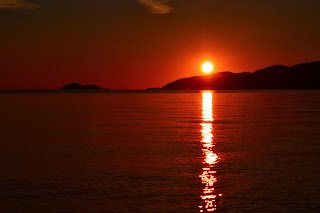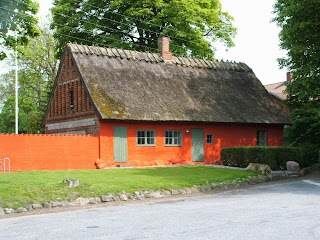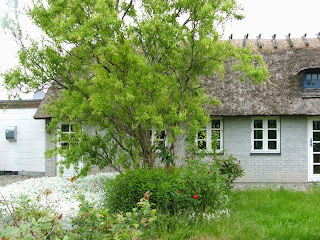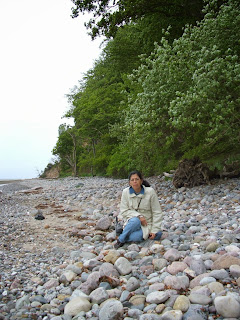 |
| A late evening sunset in June 2007 in Denmark. |
After a good breakfast the Toyota is cranked up and off we go. First to the tiny village of Petersvaerft (Petersværft) which means Peters Wharf - http://www.visitdenmark.nl/nl/denmark/petersvaerft-gdk615123
Here my aunt lived with her husband, and I can't remember his name, and their twin sons. My uncle was a game warden and caretaker for Peter's Gaard (Peter's Farm) except this place is no little farm as measured in Denmark; 450 hectares / 1112 acres of farmland and 1050 hectares / 2595 acres of forest. http://www.darlington.dk/page215.html - http://www.vordingborg.dk/Everest/Publications/Afdelinger/Institution%20Lokalarkiverne/20090428100736/CurrentVersion/Petersgaard.pdf
Most of the links I find are in Danish so you will have to use Google Translate to get the text in English.
While on summer vacations at my maternal grandparents house which was only a few kilometers away my brother Max and I would spend a lot of time at Petersværft, mostly because Ulvsund (Wolf Sound) was right there, and my uncle had a nice rowboat which we would row in the sound and sometimes borrowing my aunts sheets, we would row up wind and sail downwind. The forest was full of wild life, deer, rabbits, birds and it was truly a place for boys to explore. In addition, the bike ride from "mormor and morfars" house was a treat - the last bit of road was rather steeply down hill with a series of "steps" and one can build up considerable speed before getting to the bottom and a hard left turn. If you go to google earth and zoom in on 54 deg. 58 min 14.39 secs N and 12 deg. 04 min 30.00 sec. E and you will see Petersværft, including the road and the pier or wharf. My aunt lived in the house right on the corner.
Here are a few photos from the area.
In this building a lot of the wood used on the sailing ships built at
in Petersværft the late 1700's and into the 1800's began to take shape here.
in Petersværft the late 1700's and into the 1800's began to take shape here.
A typical house in Petersværft. My childhood home looked like this
before the present owner removed the walls and replaced them with brick.
Norma wondering if we could buy something like this?
An absolutely idyllic setting.
What peace there is in small places like this.
Now it is off to Vordingborg, a city of some size, by Danish standards, with a population of not quite 12,000 in the city but about 46,000 in the general area.http://en.wikipedia.org/wiki/Vordingborg,_Denmark - http://www.britannica.com/EBchecked/topic/632857/Vordingborg
http://en.wikipedia.org/wiki/Vordingborg
The city is old and is the home of Vordingborg Castle (ruins) and the Goose Tower (Gåsetårnet) which was a field trip from time to time from Horbelev Skole. We enjoyed the time here, not so much for the history but for a day away from school and a time to explore and play around. Therefore Norma had to see this very old piece of important Danish history. http://en.wikipedia.org/wiki/Vordingborg_Castle
What remains of the old "Vording Borg" is a large hill, some of the moat, a few ruins of walls and the famous Goose Tower http://da.wikipedia.org/wiki/G%C3%A5set%C3%A5rnet
http://www.360cities.net/image/goose-tower#224.60,-3.30,55.3
http://www.visitmoen.com/ln-int/denmark/gasetarnet-gdk615135
There are many legends and stories about the Goose Tower, the golden goose on top of the tower and the attempts to steal it, including by the Nazi's during WWII. The goose is now made out of another metal and is not nearly as desirable. The grounds of the old fortress also holds a botanical garden.
A short walk across the grass of the fortress one finds Vor Frue Kirke (The Church of Our Lady), meaning the church dedicated to the Mary, the mother of Jesus, the Theotokos. This church was completed about 1460, during what in Denmark is "politically correct" called the Catholic period, since the Protestant period didn't officially begin until 1536 when the King of Denmark established the Church of Denmark, just as a famous character established the Church of England. Originally the Church of Denmark was Catholic in all but obedience to the Roman Pontiff, but that changed with influx of the teachings of Martin Luther, and the country slowly but surely became Lutheran or as Danes say, protestant.
http://www.vordingborgkirke.dk/
http://www.bing.com/images/search?q=vor+frue+kirke+vordingborg&qpvt=vor+frue+kirke+vordingborg&FORM=IGRE
http://www.vordingborgkirke.dk/vor-frue-kirke/
Here are our photos from Vordingborg fortress, Goose Tower and the church.
Gaasetaarnet (Goose Tower) in the background.
Norma resting on a section of the old wall,
about 654 years old the day the photo was taken.
The view out of one of the windows of the tower,
note the steep ground and the moat in the center.
The walls of the tower are immensely strong,
just look how thick they are.

The tower viewed from the "attackers" point of view,
from outside the moat.
Inside Vor Frue Kirke. Note the separation of the
sacred from the profane, which has been maintained.
It is time for us to see if we can find where my godparents live. I have not seen them since 1989 and then they were living in their own home, now they are in a small apartment somewhere in the town. They don't know we are coming because we didn't have a telephone number. As luck would have it we found them and were invited in for coffee and some refreshments. We had a good couple of hours with conversation about the old days. After I went to sea they would always come to my parents house on my birthday and the day would be celebrated in my absence. Both have gone to their eternal rewards, Inge a few years ago and Anselm last year so I am glad I got to see them both.
Anselm, my godfather, to the left and Inge, my godmother, in the middle and
yours truly to the right. The scary part is that they do not look much older than I do.
From there it is time to go to Oerslev (Ørslev)
a small village where we lived for a few years and it is from here that I have my first conscious memories. My parents were managers of the forsamlingshus for a number of years - (literally translated it means "gathering house" or "meeting house"). This is the location with facilities that people would rent for weddings, anniversary celebrations, etc., in other words, proper celebrations where a multiple course menu was made, proper dinner settings made (no paper plates, plastic ware or similar). Waiters and waitresses were hired and everyone showed up proper attire for an evening of celebration. This location was or perhaps still is used after funerals for "grav oel" - the celebration of the life of the dead person - celebrated with among other things dark beer - grave beer.
The Forsamlingshus as it looks today or did in 2007.
The various website pictures that I looked at show the buildings looking the same as the above photo. We lived in the wing on the left and on the second floor and the kitchen, bathrooms are on the first floor and banquest hall in the wing at right. The staircase at the end of the building I remember well; I must have been about 4 1/2 years old when I took a backwards tumble off of the stairs, there was no railing then, and hit the back of my head on the sidewalk. I remember bleeding profusely and getting my mother all upset. It was also in this house that Max and I first did the blaming the other for something we both did. I do not remember the particular incident but we have heard about it many times.
It appears that there was to be a gathering of some importance at the forsamlingshus one morning, which would involve breakfast and a lot of "Danish Pastry" which in Denmark is called Vienna Bread (Wienerbrod - Wienerbrød). We are told that it was sitting on the counter of the kitchen to be sliced, however many pieces, but we understand there was quite a bit. It appears that prior to slicing we got into it, each eating from one end, and never quite making it to the middle, but having eaten enough to cause some concern for there being enough for the gathering; never mind the state of our stomachs'. When we were asked who did this we supposedly pointed at each other and said "he did". We were about 4 years old at the time. http://en.wikipedia.org/wiki/Danish_pastry
Here is a link to the forsamlingshus, which dates back to 1889 so in 2007 it was 118 years old. http://www.orslevforsamlingshus.dk/index.php/billeder
To the left of the buildings is a large parking lot, which has now been paved over, but back in the "good old days" it was a gravel lot, and a boy that lived on a farm behind the forsamlinghus and I would have epic battles on that parking lot with our tin soldiers, long before plastic, and in one of those battles my soldiers lost and were buried under the gravel of the parking lot. As far as I know, they are still there, just waiting for someone to come by with a metal detector to discover them and dig them up. The one and only time I have been bitten by a dog was a dog from this farm as well; I was walking up the lane one evening and apparently startled one of the dogs and it bit me pretty seriously in the leg.
The lane that leads to the farm where I and Max had friends.
The forsamlingshus is just out of sight to the right.
This building is from between 1450 and 1490 and is now used for storage.
The entrance to the Sanctuary.
A view down the nave of the church.
the raised ambo (Prædike stol - the preaching chair) to the right.
The Altar with the Menora and a
depiction of Christ after being taken down from the cross.
Like most churches in Denmark this one, dating from the mid 13th century, has a lot history, being from before the Protestant period, in other words, when the country was Catholic. The red building in front, now a storage room, is just 200 years younger.
http://www.oerslevkirke.dk/index.php?id=1648
Two more stops today; a visit to an aunt, my mothers sister and as far as I knew back then, the only one of that side of the family still alive among the aunts and the one uncle. We have her address but she does not know we are coming; she will be surprised.
We showed up and knocked on the door and there was an older version of Moster (aunt - mothers sister) Ruth and when I told her that I was Gunhild's son Allan she said "Hold da kaeft", in other words "Oh, shut up". I had not seen Moster Ruth since 1975 or perhaps earlier than that. Again, more coffee and cookies and conversation;
Two more stops today; a visit to an aunt, my mothers sister and as far as I knew back then, the only one of that side of the family still alive among the aunts and the one uncle. We have her address but she does not know we are coming; she will be surprised.
We showed up and knocked on the door and there was an older version of Moster (aunt - mothers sister) Ruth and when I told her that I was Gunhild's son Allan she said "Hold da kaeft", in other words "Oh, shut up". I had not seen Moster Ruth since 1975 or perhaps earlier than that. Again, more coffee and cookies and conversation;
Aunt Ruth Larsen
Nephew and Aunt.
I should add that Aunt Ruth husband Frederik had a blacksmith shop, back in the days when there were real blacksmiths. He also repaired farm machinery, bicycles and other odds and ends. They had, next to the blacksmith shop a gas station, one of those old gas pumps where people told you how many liters they wanted and one pumped that amount up into the glass with a hand pump, and then dispensed it into the tank of the car or motor cycle. Our uncle often patched our bicycle tires when we were vacationing at Mormor and Morfars house; our next stop for today.
Some of my fondest summer memories are from mormors and morfars house or little farm, since morfar farmed a few acres, had a few cows, one horse and a few pigs as well as chickens and ducks.
Max and I would ride our bicycles from Bregninge, cross on the ferry, bicycle across the island of Bogø, then across the island of Møn, cross the bridge between Møn and Sjaelland (Sjælland), through small village of Kalvehave (Calf garden) past the large estate known as the Hovdinggaarden (The Chiefs Farm) and up the tree lined lane to my maternal grandparents house which was first on the left. For a couple of boys, probably no more than 8 or 9 years old when we first started doing it, it was quite an adventure. The bike route was, one way, 25.6 miles / 41.2 km. Mom would pack each of us a lunch and we would have something to drink and off we went to return 10 to 14 days later. If we had flat tires along the way we would go to the nearest house, knock on the door and tell them of our dilemma. As far as I remember that only happened once, and the couple that lived there, wherever it was and whoever they were, fixed the tires and gave each of us a soft drink, something we rarely received.
It looked just as I remembered, not having been there since 1975.
Mormor and morfar have long since left this life, first morfar and a few years later mormor, and I do not know who lives in the house now because there was nobody home. Why do I have such good memories from this place? For a number of reason; first it is on a little travelled lane, second there were farm animals, third there were plenty of berry bushes as a windbreak, fourth there was forest within 150 meters, and in this forest was an old Viking grave which had been excavated.
I remember waking up in the mornings to two very distinct sounds, not counting the rooster. The sound of the birds and the wind in the trees, but also of mormor pumping pressure into the tank of her kerosene stove. Yes, the house had no electricity, it had kerosene lamps, a kerosene stove as well as a wood burning stove, it had no indoor plumbing but a well with a good old fashioned hand pump and each morning Max and I would go out and pump two buckets of water. Then we would have a great breakfast of something. Dinner was almost always followed by Æbleskiver, mormor simply made the best. Here is the link so you should try them. http://en.wikipedia.org/wiki/%C3%86bleskiver
We would spend each day exploring the forest, or riding our bicycles to Peters Wharf and row the boat there, or visit my Aunt Ruth and Uncle Frederik, as well as help mormor and morfar. We would be tasked with moving the cows once or twice a day so the grass would have a chance to grow taller.
One other memory of this location is the outhouse, which was a "two seater" and the toilet paper was yesterdays news paper and magazines. One always hoped that the paper was not glossy. They had an old RCA Victrola which we had great fun with, including the old wax records which made fantastic Frisbee's but they didn't generally survive the landing. The first summers we visited our "morbror" (mothers brother) still lived at home, since he was only about 5 or 6 years older than us. He later joined the airforce so we had the place to ourselves.
The kitchen window is on the right, and I assume the other smaller
window is also to the kitchen but I can't remember.
Since the place was empty we went off to find the old Viking grave in the forest but didn't find it. It appears that my memory was a bit off. We did hike down the forest lane and at one point was a strange sound coming from the side of the road but we didn't see anything so we kept going. What we did find was the hill we would snow ski on and learn how to turn, after the school of hard knocks had me run into a tree. The forest had been seriously damaged by heavy winds in the late 1970's and a great deal of it was knocked down but it is making a comeback. The last time it suffered seriously was during winter of 1941 (during WWII). It was a very severe winter and the sap would freeze in the trees and make the crack. Mormor and morfar, as well as my mother, would tell us of the large "cannon fire" like sounds and they were always concerned the Germans occupying that part of Denmark were busy shooting at somebody, but it was the trees simple splitting as the sap expanded when freezing.
Not the Viking grave hill, but a hill never the less.
We snow skied down this hill on Uncle's skies.
On the way back to the car we decided to check the source of the strange sound, and as we got really close we heard it again; it was a little fawn calling for its mother, and Norma told me we better get out of there because "mom" might just be upset when she comes back.
The fawn calling for "mom"
Norma walking on the forest lane.
Another day comes to a close. We have seen a lot and had some good visits. Time to go back to Frank and Lone's house.
More to follow in the next post.
















































